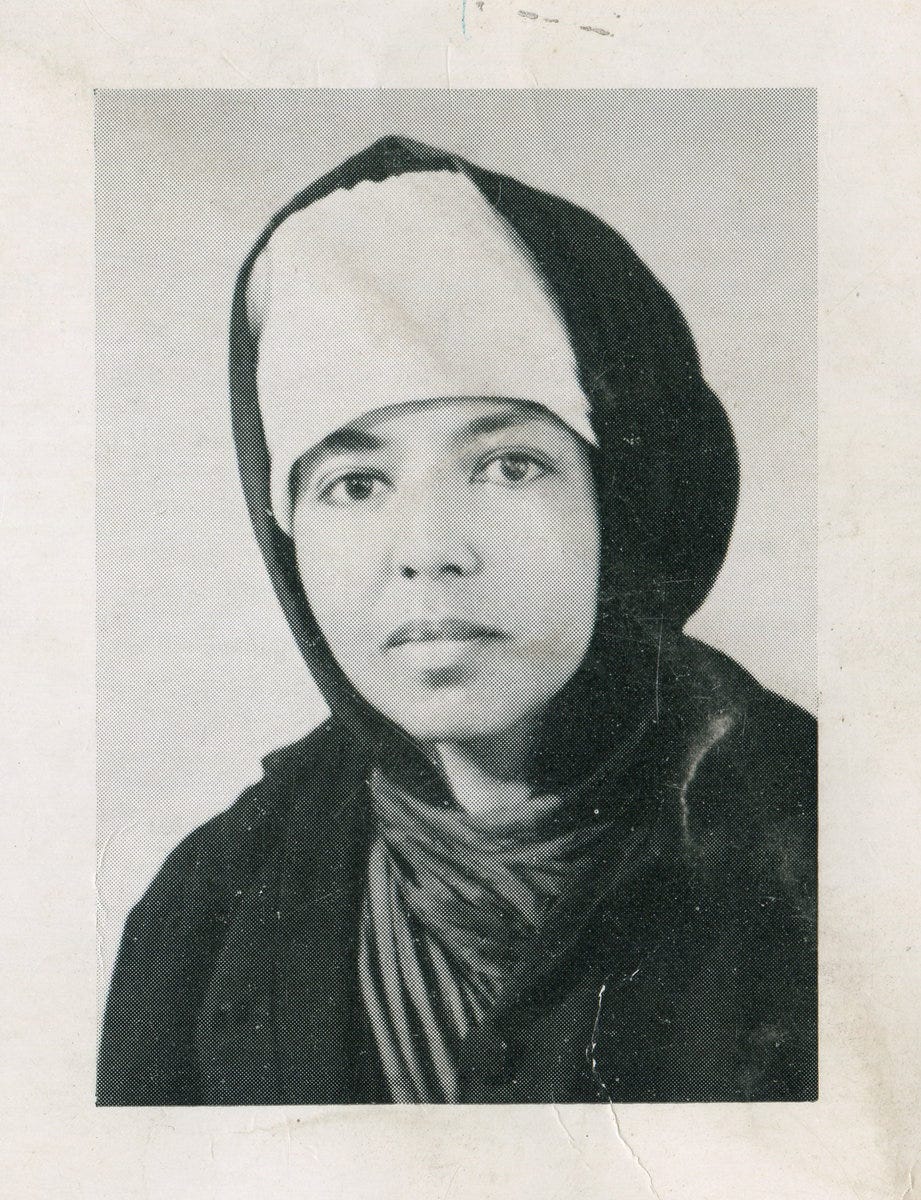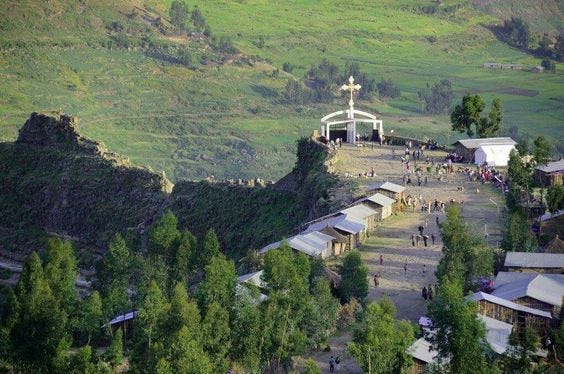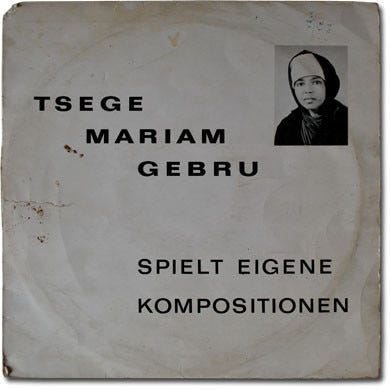We can’t always choose what life brings. But we can choose how to respond.
-Emahoy Tsegué-Maryam Guèbrou
My knowledge of Ethio-jazz is limited.
I first heard about Ethio-jazz a couple of years ago, when I was at Dusty Groove record store in Chicago and ran across Hailu Mergia & The Walias’ album Tche Belew. It was released in 2021 by Brian Shimkovitz on his excellent Awesome Tapes From Africa label, which I wrote about here.
I featured Hailu Mergia & The Walias in last week’s Ethio-jazz journey. After I posted it, I was made aware for the first time of another wonderful Ethiopian musician, Emahoy Tsegué-Maryam Guèbrou.
Although loosely grouped into Ethio-jazz, I would not consider Guèbrou a jazz artist. Her music is a free and unique fusion of Western classical tradition and ancient modal chants of the Orthodox church; however, when I listen to her music, I mostly hear the blues.
I feel in her music a melancholy longing for home, a place Guèbrou was forced to leave often in her lifetime. These feelings come out in many of her compositions. I think it’s telling that the first track on her first album, and perhaps her most known song, is The Homeless Wanderer:
The theme of loneliness and homelessness persisted in many of her later compositions. For example, in the aptly titled and bluesy Homesickness:
Ultimately, I find the story of her music a long journey to find her home.
This week on that Big River called Jazz, we’ll dig in our paddles and explore the world of Emahoy Tsegué-Maryam Guèbrou.
She was born Yewubdar Guèbrou in 1923 in Addis Ababa to a noble Ethiopian family. When she was only 6 years old, she and her sister were the first Ethiopian girls ever to be sent abroad for education, where she attended a Swiss boarding school. She studied violin and piano and heard Western classical music for the first time. Four years later, in the early 1930s, she returned to Ethiopia to study at the Empress Menen Secondary School.
During WWII, as a young teenager, she and her family were taken as prisoners of war and deported to Italy. After the war, she continued her musical studies in Cairo, Egypt. She studied with violinist Alexander Kontorowicz and later returned with him to Ethiopia to serve in Emperor Haile Selassie’s Imperial Body Guard Band.
However, when she was refused a scholarship at the Royal Academy of Music in London, the 19-year-old’s life changed forever. She abandoned music and fled Addis Ababa to join the Gishen Maryam Ethiopian Orthodox monastery, located 300 miles north of Addis Ababa in the South Wollo Zone:
At 21, she was ordained as a nun. She took on the title of “Emahoy”, meaning nun, and changed her name to Tsegué-Maryam. For ten years, she lived on the holy mountain, barefoot, in solitary prayer and meditation.
When the monastery was closed, Emahoy Tsegué-Maryam returned to Addis Ababa, where she slowly returned to music and composition. In 1963, with the help of Helia Selassi, she released in Germany her first album, Spielt Eigene Kompositionen:
Her second album, The Hymn Of Jerusalem, The Jordan River Song, was a 10” album recorded and released in 1970, also in Germany:
Her final album was Yet My King Is From Old, recorded at the Ethiopian Orthodox Patriarchy at Kidane Mehret Church in Jerusalem and released by the church in 1972:
However, in 1984, after the communist Derg regime came to power, Emahoy Tsegué-Maryam fled Ethiopia once again and, through her connections with the Kidane Mehret Church, took up residence there:
She remained at the church until she died in 2023. She was 99 years old.
Here’s a video of the 89-year-old Emahoy Tsegué-Maryam in her room at the church playing her composition, Presentiment:
On April 18, 2017, journalist Kate Molleson traveled to Kidane Mehret Church to meet with Guèbrou. A longtime fan of her music, Molleson talked with the 93-year-old musician turned nun. Here is that incredible 27-minute interview.
In her later years, to share her work with others, she started to publish her work, editing a lifetime of manuscripts with the help of Israeli musician and composer Maya Dunietz, and set up a foundation in her name to help children acquire musical instruments and music education. In her interview with Molleson, she said,
Sometimes you need to share your thoughts, your feelings - if you have a problem, it goes on the piano. If there’s some good news, it goes on the piano. If you have sadness about somebody died, it goes on the piano. I always have something to conduct. The piano was sharing my problem, my joy, everything.
Before she died, Guèbrou was able to witness an incredible musical comeback. In 2016, Buda Musique released Ethiopiques #21, an epic compilation of her solo piano music:
From that release, here is another bluesy-filled tune, The Story of the Wind:
Her music was also featured in the 2019 “Coming Home" TV ad for Amazon's Echo Auto and Echo Smart Speaker:
Her music was also featured in the motion picture industry, beginning with the 2016 American film Porto, followed later by the 2021 American film C’mon C’mon and the 2021 Netflix movie Passing. The 2023 French film Yannick and the 2024 Cannes award-winning India film All We Imagine as Light were released after her death.
Here’s one more for the road. Emahoy Tsegué-Maryam’s story made me think about that old saying, “Home is where the heart is.” But where is home? Is it the home of our parents, where we grew up, or somewhere else? Is it a physical place at all, or does it just exist in our minds? Ultimately, the heart needs a home. As Richard and Linda Thompson sang in this song: “The world's no place when you're on your own. A heart needs a home.”
Emahoy Tsegué-Maryam Guèbrou sang songs for the homeless wanderers, whose hearts are searching for a home. She found her home, and my wish is that we all can find ours.
Next week on that Big River called Jazz, we’ll dig our paddles into the waters of the 00 Corvette Special.
Please hit this link to buy me a cup of coffee if you’d like to show your guide some appreciation for this and past journeys. Know in advance that I thank you for your kindness and support.
If you like what you’ve been reading and hearing so far on our journey and would like to share this with someone you think might be interested in learning more about our great American art form, Jazz, just hit the “Share” button.
From Astaire to Sun Ra: A Jazz Journey is a reader-supported publication. To subscribe, please hit the “Subscribe now” button.
Feel free to contact me at any time to talk shop. I welcome and encourage that.
Until then, keep on walking….









So glad she was able to live long enough to get the much-deserved musical comeback story. This is a tale movies are made of! Great find.
🙏 So good to see continued appreciation of her work. There seems to be an ongoing releasing of her music since her passing with an album forthcoming later this summer. https://emahoytsegemariamgebru.bandcamp.com/album/church-of-kidane-mehret
In terms of film there’s also a great doc “Time” that uses her music to great effect. https://pitchfork.com/thepitch/time-documentary-soundtrack-garrett-bradley-interview/
And we used one of her songs in a project for the New Yorker in the late 2010s. https://youtu.be/6hIgGWaMRo4?si=1n32IAVj99D7xH1t